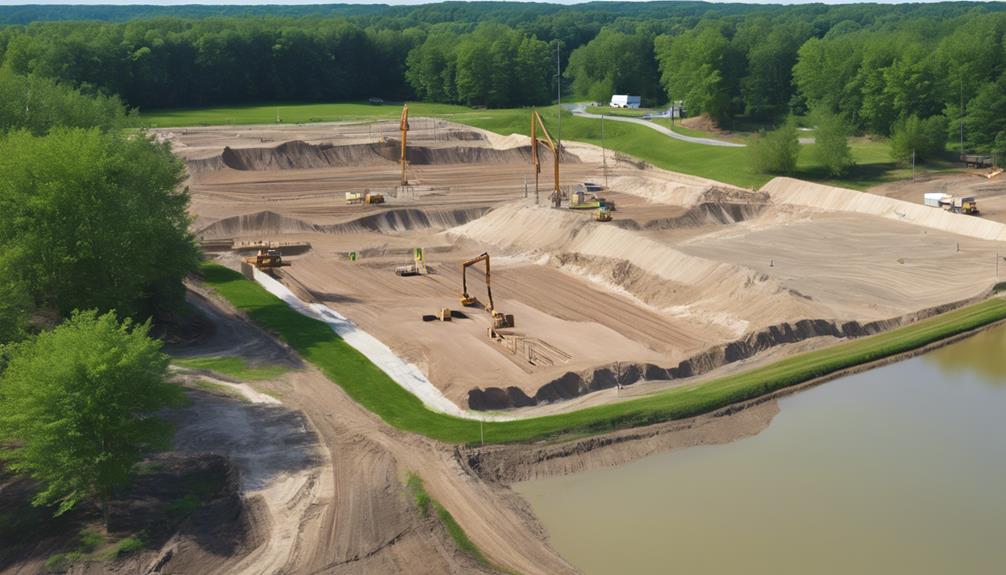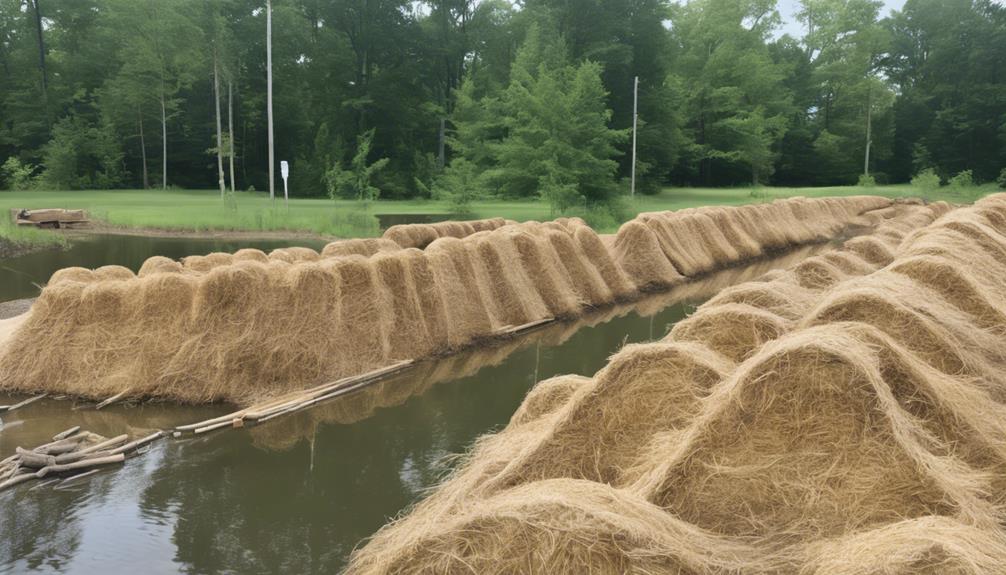When you're embarking on a construction project in Chesterfield, VA, understanding the Erosion and Sediment Control Bond is essential. This bond serves as a financial assurance that your erosion control measures will be effectively implemented, safeguarding the environment from potential harm. You'll need to consider various factors, including project size and local regulations, which can significantly impact your bond amount. But what happens if you fail to comply with these requirements? The implications could be more severe than you think, and it's vital to grasp the full scope of your responsibilities.
Importance of Erosion Control

Erosion control is vital for maintaining the integrity of our landscapes and protecting property values. When you think about the effects of soil erosion, consider how it can lead to decreased land usability and increased costs for repairs. By implementing effective erosion control measures, you not only preserve the beauty of your property but also its functionality.
You might be surprised to learn that erosion can occur in both urban and rural settings. Factors like heavy rainfall, poor landscaping practices, and construction activities can accelerate erosion, causing significant damage. By taking proactive steps, you can safeguard your land and keep it in prime condition.
Utilizing techniques such as planting vegetation, building retaining walls, and installing silt fences can help reduce erosion and protect your investment. These practices not only stabilize the soil but also enhance the aesthetic appeal of your property.
In Chesterfield, VA, understanding the importance of erosion control can benefit you greatly. You'll find that prioritizing these measures can prevent costly repairs and ensure your landscape remains intact for years to come.
Overview of Sediment Control Bond
Sediment control bonds are often required for construction projects to ensure that proper measures are in place to manage sediment runoff.
These bonds serve as a financial guarantee that you'll implement effective erosion and sediment control practices during the project. By securing this bond, you demonstrate your commitment to protecting the environment and maintaining compliance with local regulations.
When you apply for a sediment control bond, you'll typically need to outline your sediment control plan, detailing the strategies you'll use to minimize runoff and erosion.
The bond amount often depends on the size and scope of your project, as well as the potential impact on the surrounding area. If you fail to adhere to your sediment control plan, the bond can be forfeited to cover the costs of necessary corrective actions.
It's crucial to understand that sediment control bonds not only help protect the environment but also safeguard your investment.
Bond Requirements in Chesterfield

In Chesterfield, specific bond requirements are in place to ensure compliance with local regulations regarding erosion and sediment control.
When you undertake a construction project, you'll need to submit an erosion and sediment control bond. This bond serves as a financial guarantee that you'll adhere to the approved erosion control plan and restore the site after construction.
Similar to other bonds like the Texas Residential Mortgage Loan Servicer Bond, the bond amount is typically determined based on the size and scope of your project. You may need to provide a cash bond, surety bond, or other forms of financial assurance.
It's essential to ensure that the bond covers the potential costs of any necessary corrective actions if erosion or sediment issues arise during or after your project.
Before beginning work, you'll need to complete all required documentation and obtain the necessary approvals from local authorities.
Keeping your bond active throughout the duration of your project is crucial, as failing to meet requirements could result in penalties or the forfeiture of your bond.
Understanding these requirements can help you navigate the process smoothly and avoid potential setbacks.
Application Process for the Bond
To secure your erosion and sediment control bond in Chesterfield, you'll need to follow a specific application process.
First, gather all necessary documentation, including your project plans, site maps, and any required permits. This paperwork will help demonstrate your compliance with local regulations.
Next, complete the bond application form, which you can usually find on the Chesterfield County website. Be sure to provide accurate details about your project, including its scope and estimated costs. If you're unsure about any sections, don't hesitate to reach out to local officials for clarification.
Once you've filled out the application, submit it along with the required fee. This fee may vary depending on the size and complexity of your project, so check the latest guidelines to avoid surprises.
After submission, your application will undergo review by the appropriate department. They may request additional information or clarification, so be prepared to respond promptly.
If approved, you'll receive instructions on how to finalize the bond and begin your project. Following these steps will ensure a smoother application process and help you stay compliant with Chesterfield's erosion and sediment control regulations.
Financial Implications of the Bond

While securing an erosion control bond in Chesterfield can seem straightforward, it's essential to understand the financial implications involved. First, you'll need to pay a premium for the bond, which varies based on the project's size and risk factors. This cost can add up quickly, so budgeting for it ahead of time is crucial.
Moreover, you should consider the potential for forfeiture. If erosion control measures aren't properly implemented, you might lose a portion or all of the bond amount. This loss can significantly impact your project budget and timeline. It's vital to adhere strictly to the regulations to avoid these financial penalties.
You'll also want to factor in the administrative costs associated with securing and maintaining the bond. These can include fees for inspections or potential fines for non-compliance. Understanding these costs helps you prepare for the full financial picture.
Lastly, having a solid plan for erosion control can save you money in the long run. Investing in quality materials and proper oversight can reduce the likelihood of costly issues down the line. Always weigh these financial implications carefully before moving forward with your project.
Key Regulations and Guidelines
Understanding the key regulations and guidelines for erosion control in Chesterfield is crucial for the success of your project. The Virginia Erosion and Sediment Control Law mandates that all land-disturbing activities must implement effective control measures.
Before starting, you'll need to submit a comprehensive erosion and sediment control plan to the Chesterfield Department of Environmental Engineering for approval. Your plan should outline specific techniques to minimize soil erosion and manage sediment runoff.
You'll also need to comply with local ordinances, which may include maintaining buffers around water bodies and following specific grading practices. It's essential to keep records of your erosion control measures and any inspections.
Furthermore, be aware that regular inspections by the local authorities can occur throughout your project. If you fail to meet these regulations, you could face fines or project delays.
Best Practices for Erosion Control

Implementing best practices for erosion control is vital to achieving compliance with local regulations and protecting the environment. Start by conducting a thorough site assessment to pinpoint vulnerable areas prone to erosion. This will help you determine the most effective strategies tailored to your specific site conditions.
Next, utilize silt fences, sediment basins, and other barriers to intercept sediment-laden runoff. These measures can significantly reduce the amount of sediment leaving your site. Additionally, consider planting native vegetation, which provides root systems that stabilize soil and absorb water, further minimizing erosion.
Another effective method is to maintain existing vegetation where possible. Keeping natural ground cover can dramatically lower erosion rates. When grading or clearing land, try to limit disturbance to only the areas necessary for your project.
Regularly monitor your erosion control measures to ensure they're functioning effectively. If you notice any issues, act quickly to rectify them.
Lastly, educate your team about the importance of erosion control and involve them in implementing these practices. By following these best practices, you'll contribute to a healthier environment while meeting Chesterfield's regulations.
Consequences of Non-Compliance
Failing to comply with erosion control regulations can lead to serious consequences for both your project and the environment. If you ignore these regulations, you might face hefty fines that can quickly escalate, impacting your project budget.
Additionally, non-compliance can delay your project timeline as you may need to halt work to address violations. This not only disrupts your schedule but also affects your reputation with clients and stakeholders.
Moreover, poor erosion control can result in significant environmental damage. Soil erosion can lead to sediment runoff into local waterways, harming aquatic ecosystems and violating state and federal regulations. This can trigger legal actions, potentially leading to costly litigation or even mandatory restoration efforts.
Your project's integrity is also at risk. If erosion issues arise, the structural stability of your work could be compromised, leading to further repairs or reconstruction.
Ultimately, non-compliance can undermine your credibility in the industry, making it harder to secure future projects. To avoid these repercussions, it's crucial to stay informed and adhere to all erosion control guidelines throughout your project.
Resources for Developers and Contractors

Access to the right resources is essential for developers and contractors navigating erosion control regulations.
You'll want to familiarize yourself with the Chesterfield County Department of Environmental Engineering's website, where you can find guidelines, forms, and technical resources specifically designed for erosion and sediment control.
Consider attending workshops and training sessions offered by local agencies or professional organizations. These events can provide valuable insights into best practices and updated regulations.
Networking with other professionals in the field can also lead to shared knowledge and resources that may benefit your projects.
Don't forget about the Virginia Department of Environmental Quality (DEQ) website, which offers additional resources and compliance information.
Utilizing these tools can help you stay current and avoid costly mistakes.
Lastly, local libraries or universities may have access to research materials and case studies that can further enhance your understanding of erosion control measures.
Conclusion
In conclusion, securing an Erosion and Sediment Control Bond in Chesterfield, VA, is essential for your construction project's success. By understanding the bond's importance and adhering to local regulations, you not only protect the environment but also safeguard your investment. Stay proactive in implementing best practices for erosion control, and you'll avoid the pitfalls of non-compliance. Remember, a little effort upfront can save you from costly fines and ensure a smoother project experience.


